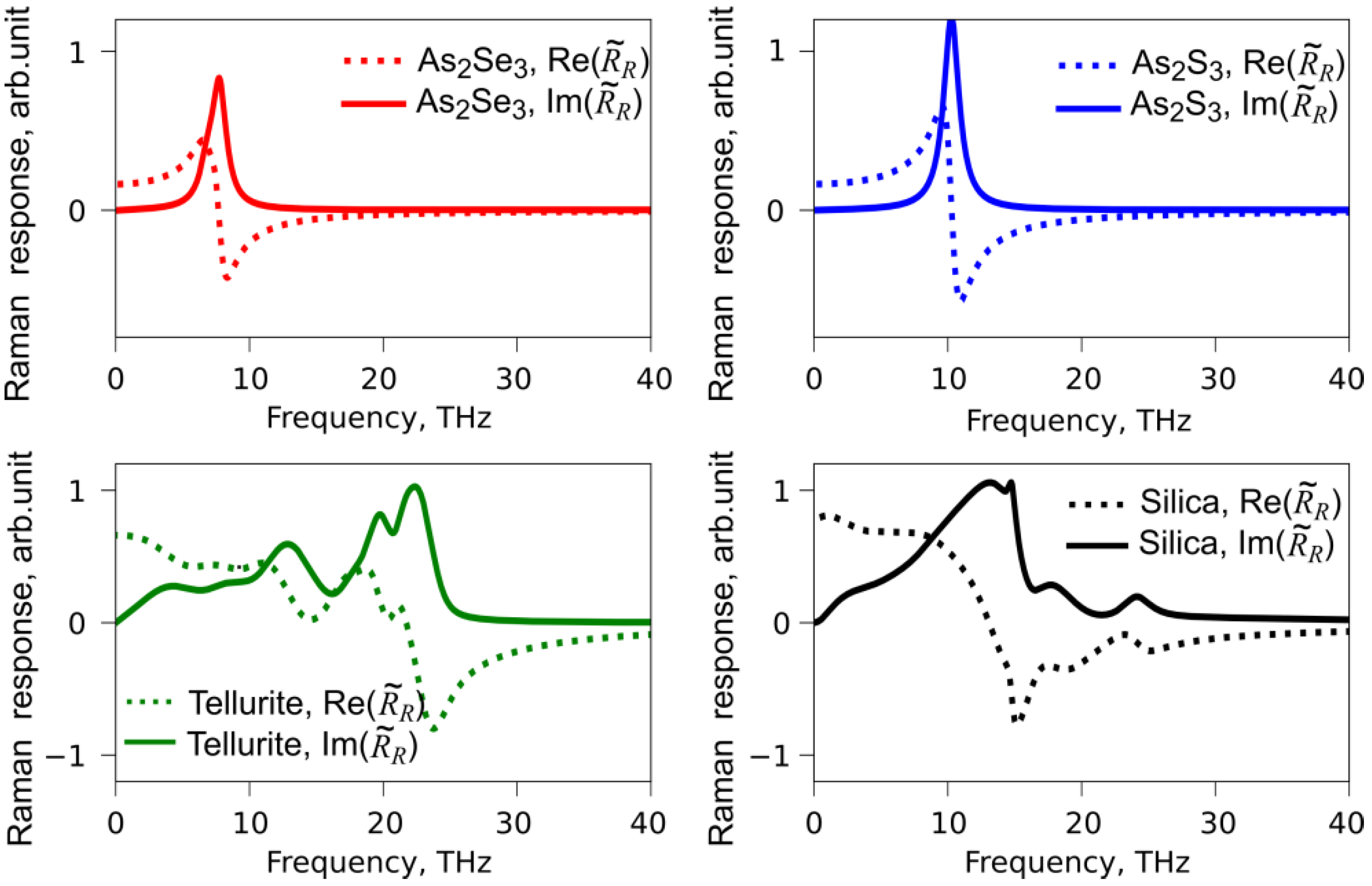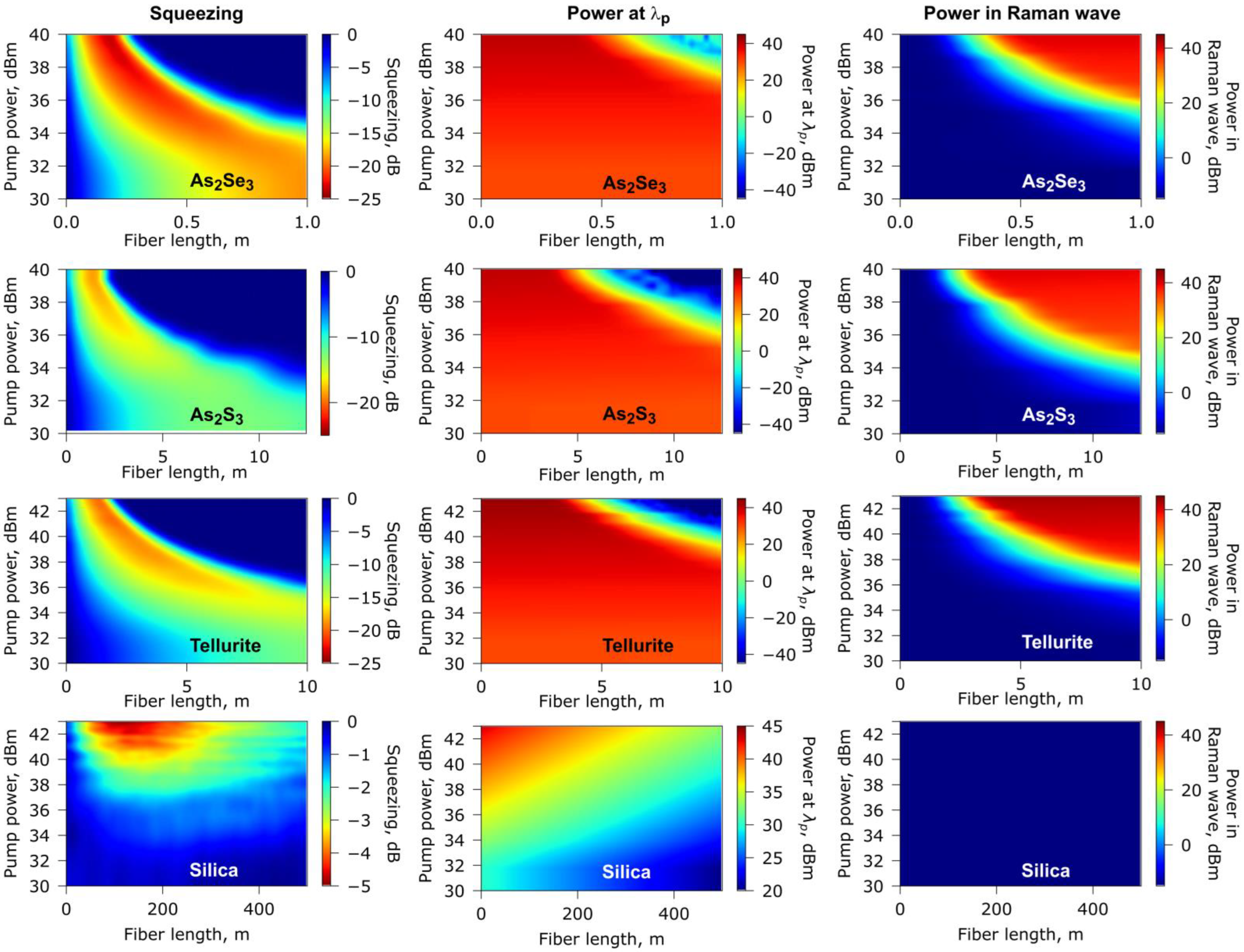Towards Quantum Noise Squeezing for 2-Micron Light with Tellurite and Chalcogenide Fibers with Large Kerr Nonlinearity
Abstract
:1. Introduction
2. Methods
3. Results
4. Discussion
Author Contributions
Funding
Institutional Review Board Statement
Informed Consent Statement
Data Availability Statement
Conflicts of Interest
References
- Andersen, U.L.; Gehring, T.; Marquardt, C.; Leuchs, G. 30 years of squeezed light generation. Phys. Scr. 2016, 91, 053001. [Google Scholar] [CrossRef]
- Schnabel, R. Squeezed states of light and their applications in laser interferometers. Phys. Rep. 2017, 684, 1–51. [Google Scholar] [CrossRef]
- Mukamel, S.; Freyberger, M.; Schleich, W.P.; Bellini, M.; Zavatta, A.; Leuchs, G.; Silberhorn, C.; Boyd, R.W.; Sánchez-Soto, L.L.; Stefanov, A.; et al. Roadmap on quantum light spectroscopy. J. Phys. B At. Mol. Opt. Phys. 2020, 53, 072002. [Google Scholar] [CrossRef]
- Appel, J.; Figueroa, E.; Korystov, D.; Lobino, M.; Lvovsky, A.I. Quantum Memory for Squeezed Light. Phys. Rev. Lett. 2008, 100, 093602. [Google Scholar] [CrossRef]
- Vahlbruch, H.; Chelkowski, S.; Danzmann, K.; Schnabel, R. Quantum engineering of squeezed states for quantum communication and metrology. New J. Phys. 2007, 9, 371. [Google Scholar] [CrossRef]
- Kaiser, F.; Fedrici, B.; Zavatta, A.; D’Auria, V.; Tanzilli, S. A fully guided-wave squeezing experiment for fiber quantum networks. Optica 2016, 3, 362–365. [Google Scholar] [CrossRef]
- Zhou, L.; Liu, P.; Jin, G.-R. Single-Port Homodyne Detection in a Squeezed-State Interferometry with Optimal Data Processing. Photonics 2021, 8, 291. [Google Scholar] [CrossRef]
- Khalil, E.; Mohamed, A.-B.; Obada, A.-S.; Eleuch, H. Quasi-Probability Husimi-Distribution Information and Squeezing in a Qubit System Interacting with a Two-Mode Parametric Amplifier Cavity. Mathematics 2020, 8, 1830. [Google Scholar] [CrossRef]
- Grote, H.; Danzmann, K.; Dooley, K.L.; Schnabel, R.; Slutsky, J.; Vahlbruch, H. First Long-Term Application of Squeezed States of Light in a Gravitational-Wave Observatory. Phys. Rev. Lett. 2013, 110, 181101. [Google Scholar] [CrossRef]
- Mansell, G.L.; McRae, T.G.; Altin, P.A.; Yap, M.J.; Ward, R.L.; Slagmolen, B.J.J.; Shaddock, D.A.; McClelland, D.E. Observation of Squeezed Light in the 2 μm Region. Phys. Rev. Lett. 2018, 120, 203603. [Google Scholar] [CrossRef] [Green Version]
- Mehmet, M.; Vahlbruch, H. The Squeezed Light Source for the Advanced Virgo Detector in the Observation Run O3. Galaxies 2020, 8, 79. [Google Scholar] [CrossRef]
- Ralph, T.C.; Lam, P.K. Teleportation with Bright Squeezed Light. Phys. Rev. Lett. 1998, 81, 5668–5671. [Google Scholar] [CrossRef]
- Taylor, M.A.; Janousek, J.; Daria, V.; Knittel, J.; Hage, B.; Bachor, H.; Bowen, W. Biological measurement beyond the quantum limit. Nat. Photonics 2013, 7, 229–233. [Google Scholar] [CrossRef]
- Lassen, M.; Delaubert, V.; Janousek, J.; Wagner, K.; Bachor, H.-A.; Lam, P.K.; Treps, N.; Buchhave, P.; Fabre, C.; Harb, C.C. Tools for Multimode Quantum Information: Modulation, Detection, and Spatial Quantum Correlations. Phys. Rev. Lett. 2007, 98, 083602. [Google Scholar] [CrossRef]
- Heinze, J.; Willke, B.; Vahlbruch, H. Observation of Squeezed States of Light in Higher-Order Hermite-Gaussian Modes with a Quantum Noise Reduction of up to 10 dB. Phys. Rev. Lett. 2022, 128, 083606. [Google Scholar] [CrossRef]
- Yan, M.; Ma, L. Generation of Higher-Order Hermite–Gaussian Modes via Cascaded Phase-Only Spatial Light Modulators. Mathematics 2022, 10, 1631. [Google Scholar] [CrossRef]
- Vahlbruch, H.; Mehmet, M.; Danzmann, K.; Schnabel, R. Detection of 15 dB Squeezed States of Light and their Application for the Absolute Calibration of Photoelectric Quantum Efficiency. Phys. Rev. Lett. 2016, 117, 110801. [Google Scholar] [CrossRef]
- Corney, J.F.; Heersink, J.; Dong, R.; Josse, V.; Drummond, P.D.; Leuchs, G.; Andersen, U.L. Simulations and experiments on polarization squeezing in optical fiber. Phys. Rev. A 2008, 78, 023831. [Google Scholar] [CrossRef]
- McCormick, C.F.; Boyer, V.; Arimondo, E.; Lett, P.D. Strong relative intensity squeezing by four-wave mixing in rubidium vapor. Opt. Lett. 2006, 32, 178–180. [Google Scholar] [CrossRef]
- Shelby, R.M.; Levenson, M.D.; Perlmutter, S.H.; DeVoe, R.G.; Walls, D.F. Broad-Band Parametric Deamplification of Quantum Noise in an Optical Fiber. Phys. Rev. Lett. 1986, 57, 691–694. [Google Scholar] [CrossRef] [Green Version]
- Rosenbluh, M.; Shelby, R.M. Squeezed optical solitons. Phys. Rev. Lett. 1991, 66, 153–156. [Google Scholar] [CrossRef] [PubMed]
- Fiorentino, M.; Sharping, J.E.; Kumar, P.; Porzio, A.; Windeler, R.S. Soliton squeezing in microstructure fiber. Opt. Lett. 2002, 27, 649–651. [Google Scholar] [CrossRef] [PubMed]
- Fiorentino, M.; Sharping, J.E.; Kumar, P.; Levandovsky, D.; Vasilyev, M. Soliton squeezing in a Mach-Zehnder fiber interferometer. Phys. Rev. A 2001, 64, 031801. [Google Scholar] [CrossRef]
- Tran, T.X.; Cassemiro, K.N.; Söller, C.; Blow, K.J.; Biancalana, F. Hybrid squeezing of solitonic resonant radiation in photonic crystal fibers. Phys. Rev. A 2011, 84, 013824. [Google Scholar] [CrossRef]
- Dong, R.; Heersink, J.; Corney, J.; Drummond, P.; Andersen, U.L.; Leuchs, G. Experimental evidence for Raman-induced limits to efficient squeezing in optical fibers. Opt. Lett. 2008, 33, 116–118. [Google Scholar] [CrossRef] [PubMed]
- Kapasi, D.; Eichholz, J.; McRae, T.; Ward, R.; Slagmolen, B.J.J.; Legge, S.; Hardman, K.S.; Altin, P.; McClelland, D. Tunable narrow-linewidth laser at 2 μm wavelength for gravitational wave detector research. Opt. Express 2020, 28, 3280–3288. [Google Scholar] [CrossRef]
- Zhang, Q.; Hou, Y.; Wang, X.; Song, W.; Chen, X.; Bin, W.; Li, J.; Zhao, C.; Wang, P. 5 W ultra-low-noise 2 µm single-frequency fiber laser for next-generation gravitational wave detectors. Opt. Lett. 2020, 45, 4911–4914. [Google Scholar] [CrossRef]
- Zervas, M.N.; Codemard, C.A. High Power Fiber Lasers: A Review. IEEE J. Sel. Top. Quantum Electron. 2014, 20, 219–241. [Google Scholar] [CrossRef]
- Richardson, D.J.; Nilsson, J.; Clarkson, W.A. High power fiber lasers: Current status and future perspectives [Invited]. J. Opt. Soc. Am. B 2010, 27, B63–B92. [Google Scholar] [CrossRef]
- Aleshkina, S.S.; Fedotov, A.; Korobko, D.; Stoliarov, D.; Lipatov, D.S.; Velmiskin, V.; Temyanko, V.L.; Kotov, L.V.; Gumenyuk, R.; Likhachev, M.E. All-fiber polarization-maintaining mode-locked laser operated at 980 nm. Opt. Lett. 2020, 45, 2275–2278. [Google Scholar] [CrossRef]
- Kamynin, V.A.; Wolf, A.A.; Skvortsov, M.I.; Filatova, S.A.; Kopyeva, M.S.; Vlasov, A.A.; Tsvetkov, V.B.; Babin, S.A. Distributed Temperature Monitoring Inside Ytterbium DFB and Holmium Fiber Lasers. J. Light. Technol. 2021, 39, 5980–5987. [Google Scholar] [CrossRef]
- Bachor, H.A.; Ralph, T.C.; Lucia, S.; Ralph, T.C. A Guide to Experiments in Quantum Optics; Wiley-vch: Weinheim, Germany, 2004. [Google Scholar]
- Tao, G.; Ebendorff-Heidepriem, H.; Stolyarov, A.M.; Danto, S.; Badding, J.V.; Fink, Y.; Ballato, J.; Abouraddy, A.F. Infrared fibers. Adv. Opt. Photon. 2015, 7, 379–458. [Google Scholar] [CrossRef]
- Eggleton, B.J.; Luther-Davies, B.; Richardson, K. Chalcogenide photonics. Nat. Photon. 2011, 5, 141–148. [Google Scholar] [CrossRef]
- Cai, D.; Xie, Y.; Guo, X.; Wang, P.; Tong, L. Chalcogenide Glass Microfibers for Mid-Infrared Optics. Photonics 2021, 8, 497. [Google Scholar] [CrossRef]
- Anashkina, E.A.; Shiryaev, V.S.; Koptev, M.Y.; Stepanov, B.S.; Muravyev, S.V. Development of As-Se tapered suspended-core fibers for ultra-broadband mid-IR wavelength conversion. J. Non-Cryst. Solids 2018, 480, 43–50. [Google Scholar] [CrossRef]
- Anashkina, E.A.; Kim, A.V. Numerical Simulation of Ultrashort Mid-IR Pulse Amplification in Praseodymium-Doped Chalcogenide Fibers. J. Light. Technol. 2017, 35, 5397–5403. [Google Scholar] [CrossRef]
- Kibler, B.; Lemière, A.; Gomes, J.-T.; Gaponov, D.; Lavoute, L.; Désévédavy, F.; Smektala, F. Octave-spanning coherent supercontinuum generation in a step-index tellurite fiber and towards few-cycle pulse compression at 2 μm. Opt. Commun. 2021, 488, 126853. [Google Scholar] [CrossRef]
- Anashkina, E.A.; Dorofeev, V.V.; Skobelev, S.S.; Balakin, A.A.; Motorin, S.E.; Kosolapov, A.F.; Andrianov, A.V. Microstructured Fibers Based on Tellurite Glass for Nonlinear Conversion of Mid-IR Ultrashort Optical Pulses. Photonics 2020, 7, 51. [Google Scholar] [CrossRef]
- Anashkina, E.A.; Andrianov, A.V. Design and Dispersion Control of Microstructured Multicore Tellurite Glass Fibers with In-Phase and Out-of-Phase Supermodes. Photonics 2021, 8, 113. [Google Scholar] [CrossRef]
- Qin, G.; Liao, M.; Suzuki, T.; Mori, A.; Ohishi, Y. Widely tunable ring-cavity tellurite fiber Raman laser. Opt. Lett. 2008, 33, 2014–2016. [Google Scholar] [CrossRef]
- Snopatin, G.E.; Churbanov, M.F.; Pushkin, A.A.; Gerasimenko, V.V.; Dianov, E.M.; Plotnichenko, V.G. High purity arsenic-sulfide glasses and fibers with minimum attenuation of 12 dB/km. Optoelectron. Adv. Mater. Rapid Commun. 2009, 3, 669–671. [Google Scholar]
- Shiryaev, V.; Churbanov, M.; Snopatin, G.; Chenard, F. Preparation of low-loss core–clad As–Se glass fibers. Opt. Mater. 2015, 48, 222–225. [Google Scholar] [CrossRef]
- Dianov, E.M.; Petrov, M.Y.; Plotnichenko, V.G.; Sysoev, V.K. Estimate of the minimum optical losses in chalcogenide glasses. Sov. J. Quantum Electron. 1982, 12, 498–499. [Google Scholar] [CrossRef]
- Anashkina, E.A.; Andrianov, A.V.; Corney, J.F.; Leuchs, G. Chalcogenide fibers for Kerr squeezing. Opt. Lett. 2020, 45, 5299–5302. [Google Scholar] [CrossRef]
- Available online: https://irflex.com (accessed on 12 September 2022).
- Agrawal, G.P. Nonlinear Fiber Optics, 6th ed.; Elsevier: Amsterdam, The Netherlands, 2019. [Google Scholar]
- Singh, M.; Singh, A. The Optimal Order Newton’s Like Methods with Dynamics. Mathematics 2021, 9, 527. [Google Scholar] [CrossRef]
- Available online: http://www.amorphousmaterials.com (accessed on 12 September 2022).
- Ghosh, G. Sellmeier Coefficients and Chromatic Dispersions for Some Tellurite Glasses. J. Am. Ceram. Soc. 1995, 78, 2828–2830. [Google Scholar] [CrossRef]
- Drummond, P.; Corney, J. Quantum noise in optical fibers I Stochastic equations. J. Opt. Soc. Am. B 2001, 18, 139–152. [Google Scholar] [CrossRef]
- Corney, J.; Drummond, P. Quantum noise in optical fibers II Raman jitter in soliton communications. J. Opt. Soc. Am. B 2001, 18, 153–161. [Google Scholar] [CrossRef]
- Bonetti, J.; Hernandez, S.; Grosz, D.F. Master equation approach to propagation in nonlinear fibers. Opt. Lett. 2021, 46, 665–668. [Google Scholar] [CrossRef]
- Sorokin, A.A.; Anashkina, E.A.; Corney, J.F.; Bobrovs, V.; Leuchs, G.; Andrianov, A.V. Numerical Simulations on Polarization Quantum Noise Squeezing for Ultrashort Solitons in Optical Fiber with Enlarged Mode Field Area. Photonics 2021, 8, 226. [Google Scholar] [CrossRef]
- Yuan, W. 2–10 μm mid-infrared supercontinuum generation in As2Se3 photonic crystal fiber. Laser Phys. Lett. 2013, 10, 95107. [Google Scholar] [CrossRef] [Green Version]
- Xiong, C.; Magi, E.; Luan, F.; Tuniz, A.; Dekker, S.; Sanghera, J.S.; Shaw, L.B.; Aggarwal, I.D.; Eggleton, B.J. Characterization of picosecond pulse nonlinear propagation in chalcogenide As(2)S(3) fiber. Appl. Opt. 2009, 48, 5467–5474. [Google Scholar] [CrossRef] [PubMed]
- Yan, X.; Qin, G.; Liao, M.; Suzuki, T.; Ohishi, Y. Transient Raman response effects on the soliton self-frequency shift in tellurite microstructured optical fiber. J. Opt. Soc. Am. B 2011, 28, 1831–1836. [Google Scholar] [CrossRef]



| Parameter | Symbol | Dimension | Type of Glass Fiber | |||
|---|---|---|---|---|---|---|
| As2Se3 | As2S3 | Tellurite | Silica | |||
| Core diameter | d | µm | 2.6 | 5 | 2.7 | 8.2 |
| Numerical aperture | NA | 0.58 | 0.3 | 0.5 | 0.14 | |
| Nonlinear Kerr coefficient | γ | (W km)−1 | 5000 | 400 | 200 | 0.6 |
| Dispersion coefficient | β2 | ps2/km | 790 | 350 | 170 | −80 |
| Fraction of the Raman contribution | fR | 0.1 | 0.1 | 0.51 | 0.2 | |
| Optical loss | α | dB/km | 60 | 50 | 20 | 20 |
| Pump wavelength | λp | µm | 2 | |||
| Temperature | T | K | 300 | |||
Publisher’s Note: MDPI stays neutral with regard to jurisdictional claims in published maps and institutional affiliations. |
© 2022 by the authors. Licensee MDPI, Basel, Switzerland. This article is an open access article distributed under the terms and conditions of the Creative Commons Attribution (CC BY) license (https://creativecommons.org/licenses/by/4.0/).
Share and Cite
Sorokin, A.A.; Leuchs, G.; Corney, J.F.; Kalinin, N.A.; Anashkina, E.A.; Andrianov, A.V. Towards Quantum Noise Squeezing for 2-Micron Light with Tellurite and Chalcogenide Fibers with Large Kerr Nonlinearity. Mathematics 2022, 10, 3477. https://doi.org/10.3390/math10193477
Sorokin AA, Leuchs G, Corney JF, Kalinin NA, Anashkina EA, Andrianov AV. Towards Quantum Noise Squeezing for 2-Micron Light with Tellurite and Chalcogenide Fibers with Large Kerr Nonlinearity. Mathematics. 2022; 10(19):3477. https://doi.org/10.3390/math10193477
Chicago/Turabian StyleSorokin, Arseny A., Gerd Leuchs, Joel F. Corney, Nikolay A. Kalinin, Elena A. Anashkina, and Alexey V. Andrianov. 2022. "Towards Quantum Noise Squeezing for 2-Micron Light with Tellurite and Chalcogenide Fibers with Large Kerr Nonlinearity" Mathematics 10, no. 19: 3477. https://doi.org/10.3390/math10193477
APA StyleSorokin, A. A., Leuchs, G., Corney, J. F., Kalinin, N. A., Anashkina, E. A., & Andrianov, A. V. (2022). Towards Quantum Noise Squeezing for 2-Micron Light with Tellurite and Chalcogenide Fibers with Large Kerr Nonlinearity. Mathematics, 10(19), 3477. https://doi.org/10.3390/math10193477







